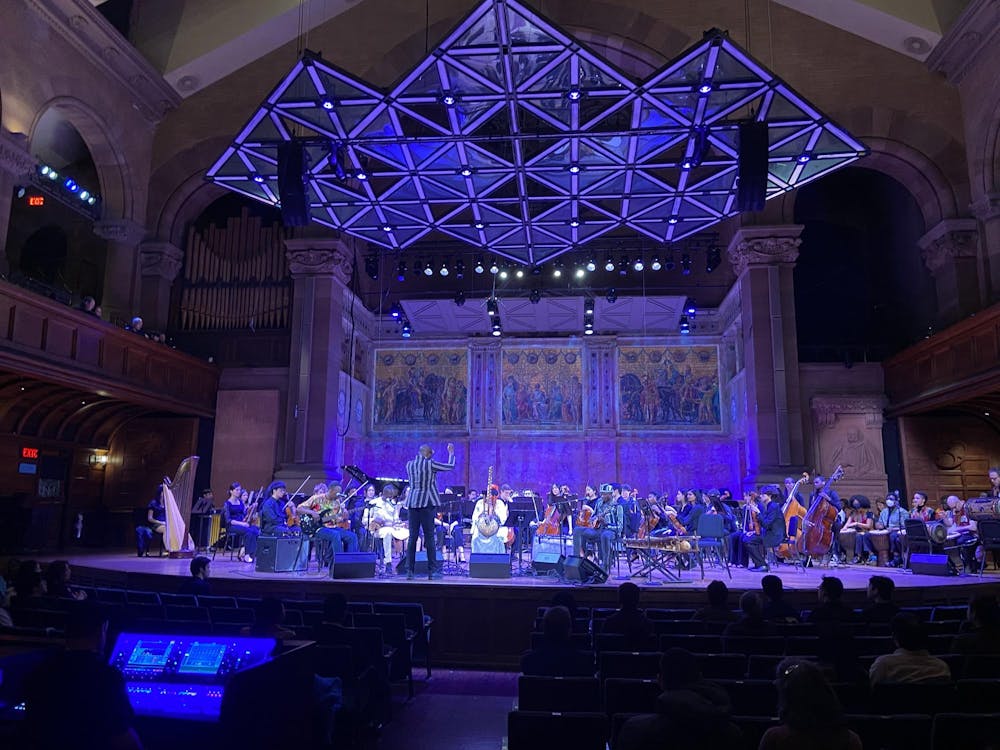The Princeton University Orchestra (PUO), the African Music Ensemble, and the Dafra Kura band presented the world premiere of “Be Kūnū” during the PUO’s “Concerto Concert” in Richardson Auditorium on Mar. 1 and 2. Three soloists — Wesley Sanders ’26, Kaivalya Kulkarni ’26, and Daniel Lee ’27 each had impressive performances during the first half of the concert. Sanders played Ralph Vaughan Williams’ Tuba Concerto, while Kulkarni played Robert Schumann’s Cello Concerto in A minor. After a short intermission, Lee performed Tchaikovsky’s Violin Concerto.
The stage was then set up for the orchestra, the African Music Ensemble, and Dafra Kura to perform “Be Kūnū,” a piece in four parts composed and directed by Olivier Tarpaga. The project was born from a conversation between Tarpaga and Michael Pratt, the PUO’s conductor. Tarpaga and Pratt sought to foster unity and cultural diversity by bringing together ancient African music and western classical music. “Be Kūnū” is written in the Bambara language of West Africa and translates to, in Tarpaga’s words, “the Present Past.”
“The project is all about the past happening today,” Tarpaga said. His composition mixes the traditional and modern — the orchestra’s strings and winds place a contemporary spin on the traditional sounds of ancient Mandingo strings from the 13th century.
The band Tarpaga directs, Dafra Kura, hails from Burkina Faso and consists of Boubacar Djiga on the djeli n’goni, an ancient Mandingo guitar, Seydou Koïta on the electric guitar, Issouf Dembélé on the balafon, a gourd-resonated xylophone, and Wassa Kouyaté, who sings and plays the kora, a 21-stringed harp. Tarpaga refers to his band members as griots: West African guardians of the oral tradition, an ancient method of music-making.
Tarpaga’s own musical process centers around the oral tradition. He chooses to create and pass down music orally because it “bring[s] the musician to connect to the humanity of the music and be more into the feel than into the rules of the music.” Though Tarpaga teaches his compositions to Dafra Kura and the African Music Ensemble through vocal communication, Beth Meyers arranged his compositions into sheet music for the orchestra, a process that involved Tarpaga singing and explaining the parts of each instrument in the piece for Meyers to transcribe onto the page. Tarpaga relies on his memory instead of using sheet music, as evidenced by the lack of a music stand in front of him during the concert. Dafra Kura and the African Music Ensemble also had nothing in front of them during the performance.
Tarpaga’s process was displayed throughout the performance. Since the piece did not rely on sheet music, musical direction became uniquely reflected in Tarpaga’s method of conducting. He used energetic visual cues and dramatically different gestures for different sounds — punches for drum beats, flicks for light pizzicato on the strings, and chops for crisp plucks on the kora. Tarpaga would sway and dance to the music, both creating and reciprocating the infectious energy produced by the ensembles.
The first song “Miniamba (to Windega),” is dedicated to Tarpaga’s daughter. The song began with a melody played by Kouyaté on the kora, which was enveloped into a beautiful layering of unique timbres as the drums, orchestra, piano, and Kouyaté’s voice joined in. The percussion of the African Music Ensemble drove the energy of the song. The second song, “Kulanjan,” was light and playful, its complex rhythms and overlapping melodies providing a delightfully engaging experience for the audience. This lively character continued into “Kongoba,” in which traditional African instruments and western instruments of the orchestra found a playful and unexpected harmony as contrasting instruments took turns darting in and out of focus. Finally, “Mali Sadio” opened with an impressive piano solo that had a strong contemporary jazz presence. The melody was handed off to Kouyaté’s voice at the end of the song. As the rest of the stage joined in the singing, Tarpaga turned to the audience and gestured at us to snap our fingers with the performers in unity.
Most impressive was Tarpaga’s ability to blend the contrasting timbres of instruments from distinct cultures and multiple time periods while simultaneously preserving the unique character of each instrument.

“We’re not sure that this has been done in the U.S. yet. So, for us, we’re almost walking somewhere on the edge of history,” Tarpaga said in reference to the collaboration between the symphony orchestra and ancient Mandingo strings.
”And guess what, it’s going to be done by students at Princeton. That means the whole world to me as a faculty member.”
Sophie Zhang is a contributing writer for The Prospect at the ‘Prince.’ She can be reached at sophiezhang[at]princeton.edu.
Please send any corrections to corrections[at]dailyprincetonian.com.

Correction: A previous version of this article misidentified composer Robert Schumann as Richard Schumann.








